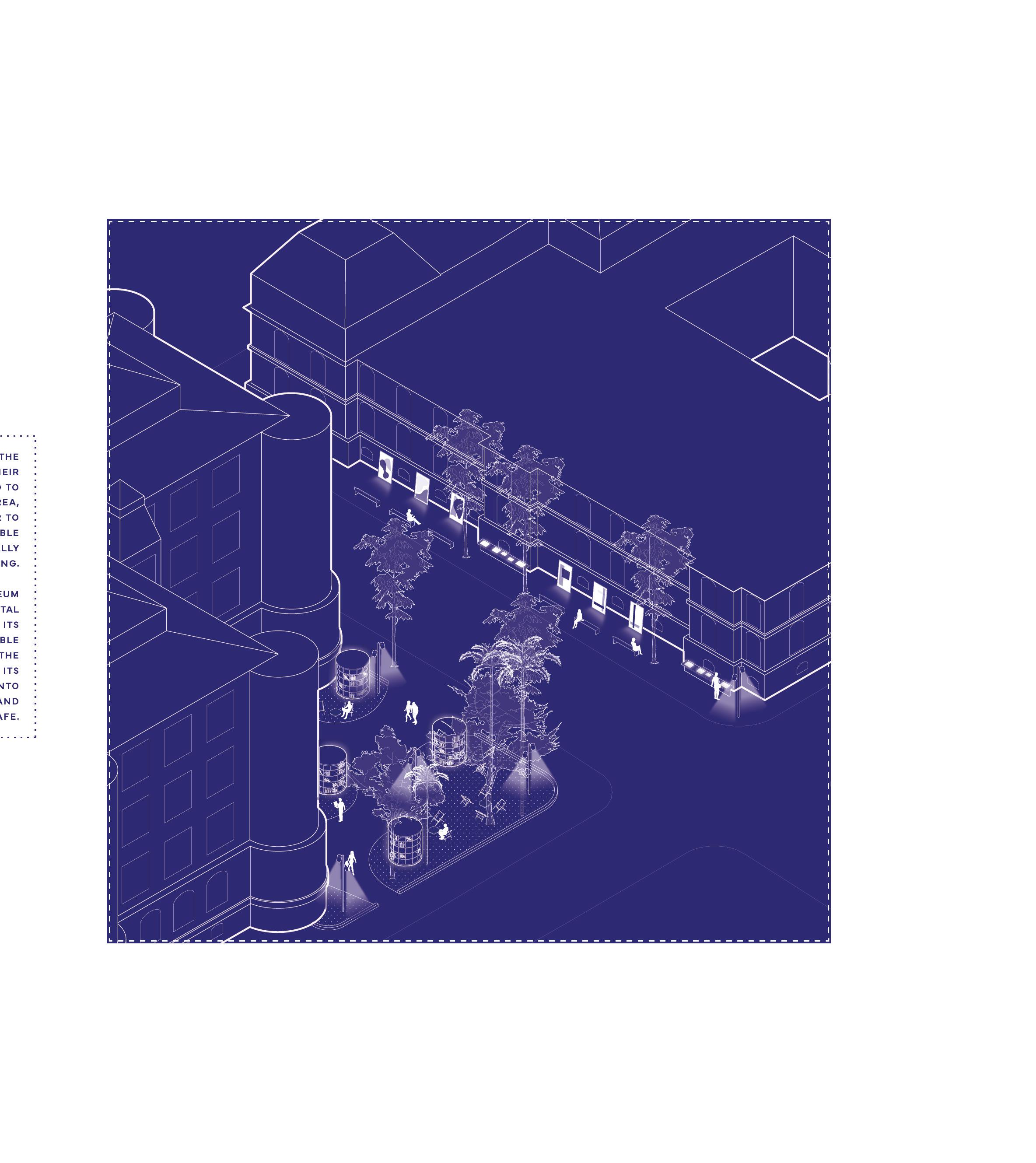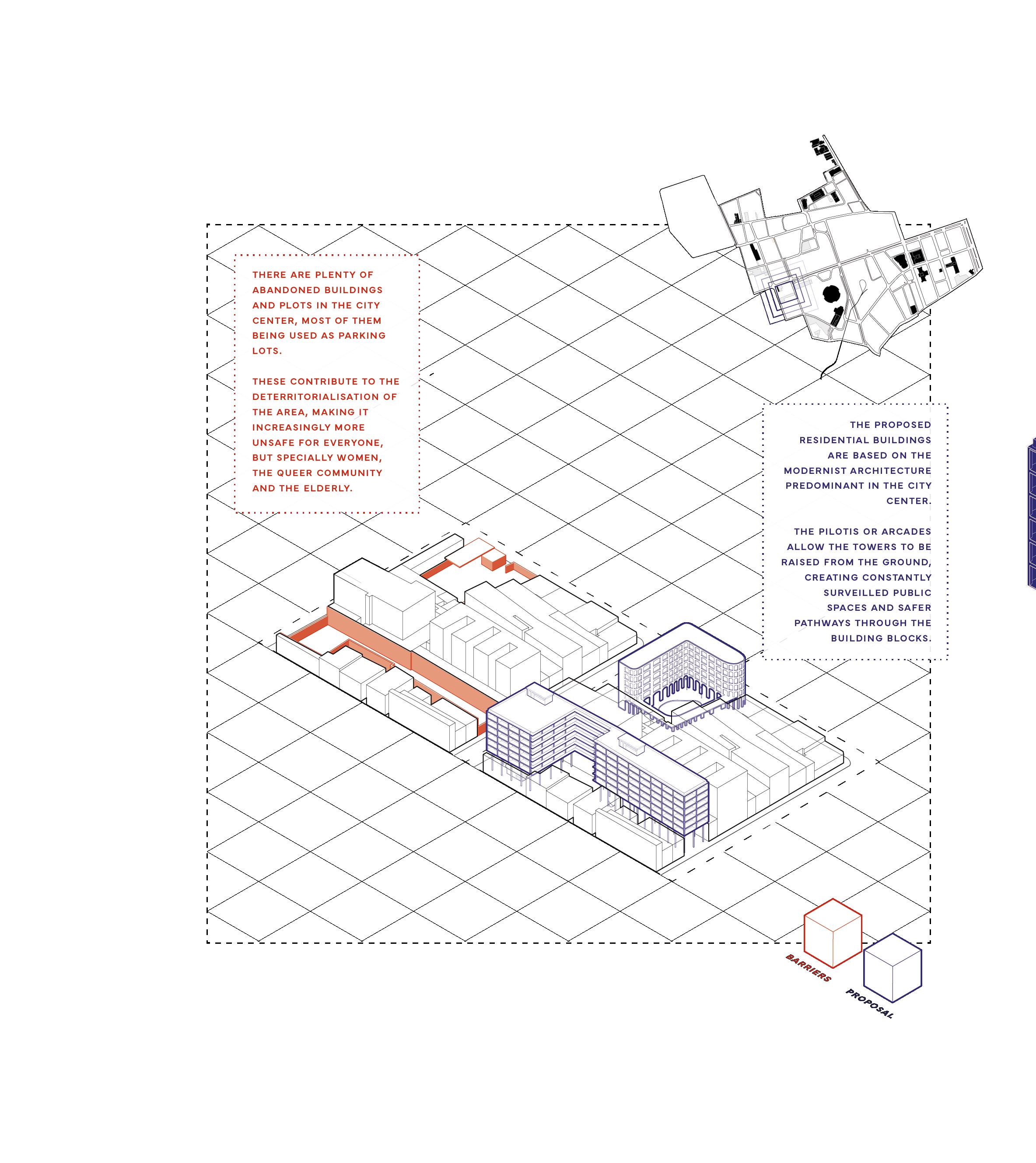

Hello, BEATRIZ CAON AMENTA
ABOUT ME
I am an architecture graduate who defines their approach as collaborative, multi-scalar and intersectional. I strongly believe that if architecture acknowledges society’s intrinsic diversity and complexity, it can hold great potential for sociopolitical change. I stand by unpretentious but critically studied interventions that inspire a transformative attitude within communities. I am particularly interested in public and collective spaces, which does not imply a preference for larger scales. I am convinced even the smallest architectural gesture can have territorial impact and influence societal dynamics. I have experimented with multiple approaches - from more classical to unconventional - and contexts - from informal settlements to remote locations -, always using interdisciplinary oriented theory to inform my practice.

One of my main interests within architecture is communication, either verbal or visual. I am a graphic design, animation and film enthusiast, and enjoy using these skills to come up with innovative ways to make the architectural process a shared one. It is fundamental for me to understand how to engage in conversations with local communities and translate these interactions into inclusive and adaptive architectural solutions.
my name is
Born in Rio de Janeiro, Brazil
IMMERSIVE DRAWING EXTENSION COURSE
DEPARTMENT OF ANALYSIS AND REPRESENTATION OF THE FORM, U NIVERSIDADE F EDERAL DO R IO DE J ANEIRO
JULY
HIGH SCHOOL DIPLOMA
COLÉGIO SANTO AGOSTINHO - NOVO LEBLON
AMONG THE 5% BEST STUDENTS
BACHELOR OF ARCHITECTURE AND URBANISM
FACULTY OF ARCHITECTURE AND URBANISM, U NIVERSIDADE F EDERAL DO R IO DE J ANEIRO
BIOCONSTRUCTION INTENSIVE COURSE : BIOSTRUCTURE AND BAMBOO FINISHINGS SUSTENTARTE
AUGUST
ARCHITECTURE INTERNSHIP
GERA BRASIL CONSULTORIA E ARQUITETURA
development of presentation material for the instituto tomie ohtake architecture award
AUGUST
SUMMER ARCHITECTURE INTERNSHIP
PEDRO BRÍGIDA ARQUITECTOS
development and photography of study and presentation models
JULY
VIDEO AND DESIGN STUDENT JOB
ALT_SHIFT RESEARCH GROUP, KU LEUVEN recording and editing of presentation videos, development of visual identity
AUGUST - NOVEMBER
BOOK LAUNCH LIVECAST : MANIFESTO FOR A JUST CITY VOL II
PAKHUIS DE ZWIJGER
book publication, event speaker
ARCHITECTURE INTERNSHIP PLAN COMÚN
3D modelling, detailing, building and furniture design, concept diagrams
MARCH -
BACHELOR OF ART OF BUILDING
DEPARTMENT OF ARCHITECTURE, UNIVERSITY OF COIMBRA
MERIT SCHOLARSHIP AWARD
2017/2018, 2018/2019 AND 2019/2020
ANNUAL STUDENT’S DESIGNS EXHIBITION
2017/2018 AND 2018/2019
3% BEST STUDENTS AWARD
2017/2018
to Coimbra, Portugal Moved to Brussels, Belgium
MASTER OF ARCHITECTURE
FACULTY OF ARCHITECTURE, KU LEUVEN
GRADUATED WITH MAGNA CUM LAUDE


master thesis
urban field lab
Multi-scalar strategic urban interventions, participative methodology

Rio de Janeiro, Brazil
Studio Fragilities, Master of Architecture, KU Leuven
Tutored by Anuschka Kutz
Individual Project
2021/2022
Rio de Janeiro has been consolidating itself as a sociospatially segregated city during the last decades, where the diverse interactions that characterize the democratic urban experience are gradually replaced by an increasing desire for differentiation from the other and an almost impenetrable social cohesiveness between equals. Motivated by fear, polarization and stigma, this tendency translates to processes of self-segregation and imposed segregation materialized in the form of territorial enclaves. The result is a city built upon a hostile and segregationist mentality, fragmented in homogeneous parts of a whole that struggles to keep its pieces connected.
The thesis is rooted on the principle that urban projects should be based on an intersectional analysis of the power and discrimination dynamics that shape the social and physical space of a city. In order to implement this idea and understand
the shifting territorial dynamics that compromise Rio’s urbanity, the research borrowed the expression “Selective Permeability” from Biology. It refers to the capacity of the plasmatic membrane to select or filter which substances can enter a cell. An analogous phenomenon can be seen on the carioca urban realm: to access a territory, one must face a series of barriers, which can be as substantial as a barbed wire fence or as subjective as a biased glance. In Rio de Janeiro, such process grew to be considerably selective and, consequently, spaces that should hold diverse and inclusive encounters become increasingly less permeable.
The project attempts to find patterns that relate Selective Permeability to spatial configurations, using the obtained knowledge to propose interventions that reintroduce trust and tolerance to the city, also paving the ground for other projects that can renew Rio’s urbanity.

While there seems to be some understanding of the barriers that surround rigidly defined territorial enclaves such as gated communities and most favelas in Rio, not enough has been said about the effects of these territorialisation processes on the spaces in between the “islands”. The thesis focus on these: spaces where the placement of intangible barriers is a consequence of the claim of certain territorial identities over the area or of the lack of any sort of appropriation. Despite their allegedly collective or public nature, these spaces have their use restricted according to relations of power, oppression and discrimination. Aspects that compose an individual’s identity then become the main parameter to determine if a territory presents itself as permeable or not.

The city’s current state of generalized fear and intolerance fits quite decently into the following analogy: if the territorial enclaves such as gated-communities or favelas are the islands, the space in between is an unpredictable sea, open to be explored but that few are willing to swim in. This sea represents the collective spaces that, despite their delusory openness, seem to be penetrable for some and not for others. The barriers that define its accessibility are not always as tangible as the operation of private security or barbed wire fences. They seem to be far more subjective or relative, even personal.
At the same time that the middle class and the elite isolate themselves in their isles of sameness, where the discomfort of facing the other is almost out of reach, the marginalized groups of Rio’s society see themselves being forced into their own territorial enclaves, either in the peripheries – where they are conveniently out of sight – or in the favelas – which, although not quite out of sight, are most defi nitely out of mind.

SELF - SEGREGATION
MACRO/MICRO SCALE SEGREGATION ]
CITY- PRIVATE ENCLAVE
PERIPHERISATION




[ MACRO SCALE SEGREGATION ]
CENTER - PERIPHERY
IMPOSED SEGREGATION
[ MICRO SCALE SEGREGATION ]
NEIGHBORHOOD - FAVELA




 FRONT 1 , PHASE 1 [ PAVING THE GROUND FOR SAFE INHABITING ] , INTERVENTION 1.4
FRONT 1 , PHASE 1 [ PAVING THE GROUND FOR SAFE INHABITING ] , INTERVENTION 1.4
 INTERVENTION 1.4 , CULTURAL OCCUPATION AS NIGHT TIME SAFETY, NIGHT VIEW
INTERVENTION 1.4 , CULTURAL OCCUPATION AS NIGHT TIME SAFETY, NIGHT VIEW
 FRONT 1 , PHASE 1 [ PAVING THE GROUND FOR SAFE INHABITING ] , INTERVENTION 1.5
FRONT 1 , PHASE 1 [ PAVING THE GROUND FOR SAFE INHABITING ] , INTERVENTION 1.5
INTERVENTION 1.5 , PRESERVING ARCHITECTURAL HERITAGE THROUGH SOCIAL USE, DAY VIEW

 FRONT 1 , PHASE 1 [ PAVING THE GROUND FOR SAFE INHABITING ] , INTERVENTION 1.6
FRONT 1 , PHASE 1 [ PAVING THE GROUND FOR SAFE INHABITING ] , INTERVENTION 1.6
 INTERVENTION 1.6 , EXTENDING THE CINEMA TO THE PUBLIC ( SPACE ) , NIGHT VIEW
INTERVENTION 1.6 , EXTENDING THE CINEMA TO THE PUBLIC ( SPACE ) , NIGHT VIEW
 FRONT 1 , PHASE 2 [ RESIDENTIAL REVIVAL ] , INTERVENTION 2.5
FRONT 1 , PHASE 2 [ RESIDENTIAL REVIVAL ] , INTERVENTION 2.5
INTERVENTION 2.5 , CONTINUOUS USAGE/CONTINUOUS SAFETY, DAY VIEW

 FRONT 1 , PHASE 2 [ RESIDENTIAL REVIVAL ] , INTERVENTION 2.7
FRONT 1 , PHASE 2 [ RESIDENTIAL REVIVAL ] , INTERVENTION 2.7
 INTERVENTION 2.7 , RESIDENTIAL BLOCKS = SAFETY CORRIDORS, NIGHT VIEW
INTERVENTION 2.7 , RESIDENTIAL BLOCKS = SAFETY CORRIDORS, NIGHT VIEW
refuge
to build in a walled forest
Off-grid flexible dwellings
Sohier, Belgium
Reverse Perspective Studio, Master of Architecture, KU Leuven
Tutored by Wim Goes
Individual Project
2021
The studio’s exercise was based on the request of a real client, a technology expert who acquired a piece of land overtaken by nature, wishing to turn the place into an off-grid escape for him, his family and others who share his philosophy. Besides complying with the challenging programmatic and technical demands, the architectural proposal should emerge from process of crossing artistic and architectural references, from Malevich’s “Black Circle”; passing through Barragán’s “Casa Gilardi’’; to Flores y Prats’ chapel for the Venice Biennale. The common element identified across the references was spiritually by abstraction. Therefore, the proposed architectural intervention should be able to provide a spiritual experience detached from traditional representational religious imagery, allowing mass and void; light and shadow; silence and sound to speak for themselves. Spirituality doesn’t fit into associations: it can be conveyed through abstract –but not always immaterial – elements; through an experience that is maybe empty of symbolism but full of meaning.


The terrain bought by the client used to be part of the Castle’s property. Nowadays, it is used by the villagers to plant ornamental flowers.
The walls that used to frame the vegetable and flower garden, now contain an uncontrolled forest.
context off-grid
The client’s wish was for the project to work completely off-grid. This diagram describes how water harvesting, sewage treatment and energy and heat collection are dealt with in a sustainable way.
On the refuges, the system is located in the space between each pair of units and covered by a pergola. The sewage treatment elements were properly integrated in the landscape design of the project, with an ornamental grey water receiver on the north side and wetlands to receive treated black waters on the south side.
 rain water
rain water
passive house

The geometry and materiality of the refuge were thought in a way that allows passive heating and ventilation. The light that comes during summer is subtle, whereas during winter, the sun can reach the whole depth of the house and warm up the terracota tiles.
flexible furniture
Each refuge should be able to host different configurations of friends and family, as well as to work either as temporary or long term homes. To achieve that, the main furniture is based on one piece that covers the depth of the refuge and contains “rails” where different pieces can slide.


light tests on cement model
The contemplative and spiritual functions of light work together with its potential for passive heating. In the Refuge, the openings are cut in a way that respects the constructive methods and allows the sunlight to enter with the strenght and presence of an architectural element.


throne square
contested colonial legacy in brussels
Intervention in existing public square and surroundings
Brussels, Belgium
Contested Colonial Legacy Studio, Master of Architecture, KU Leuven
Tutored by Wim Oers
2020
The Black Lives Matter movement brought to light an issue of contested colonial legacy being portrayed in public spaces in an unrevised and uncritical manner. It is the case of the Throne Square in Brussels, where an equestrian statue of Belgian king Leopold II is centrally placed, as a figure to be celebrated. The square lacks any depiction of the brutal history of his ownership over what was called the Congo Free State, a period well known for its especially cruel nature among colonial regimes. Leopold’s statue has been vandalised multiple times over the last years, highlighting the importance of rethinking its place in the city and its collective memory.
The proposal aims to ressignify the statue and its function in the public space by reshaping the Throne Square in a way that tells a shared historical narrative. Instead of being a residual space attached to trauma and controversy, the Square should be a place for political and cultural encounters, where all sides of history are displayed equally and Congo’s cruel colonisation can be properly acknowledged.

The group’s proposal started from one central design decision: to keep the statue of Leopold II in the Square, as opposed to destroying it or moving it to a museum. The team believed that Leopold’s statue could still play a part in the process of decolonising Brussels’ public space - if contextualised correctly.
The Throne Square is shaped not only by an imbalance of historical representation , but also by a series of urban issues. While being located between these neighbourhoods with very distinctive identities should make the Throne Square a cultural and geographical meeting point, the site feels completely disconnected from its surroundings, being cut off from its context by a road with very intense traffic. Moreover, the lack of urban furniture, shade and coverage reduces the possibility of the Square being used as a permanence space. Its spatial organisation holds very limited potential for appropriation and diversified use.

Taking all of these issues into consideration, the team decided that the new Throne Square should be a place that tells the history of Belgium and Congo’s colonial past from multiple perspectives, while also being a space that can be appropriated by the population in different ways. To tell these stories, we conceived three “ historical paths ”: urban routes that contain historical information - such as signs and QR codes engraved on the corten steel finishing - and connect the Throne Square to other key spaces. One connects the square to Brussels Park, displaying information about the legacy of Leopold II in Belgium. A second one links it to the Patrice Lumumba Square, and it exhibits facts about the Belgian colonial rule over Congo. The last one takes the form of an urban platform, which connects the Throne Square to the metro station of the same name and allows pedestrians to cross the Ring Road safely. This historical path contains signs that showcase the history of the Square itself, from when it was created to the recent protests.

appropriable public space






ACTIVISM
HISTORICAL TOURISM
PERFORMANCE / EDUCATIONAL
LOCAL MARKET






arcadia
modular housing system
Dwellings for 1 to 4 people, public space, common rooms
Coimbra, Portugal
Project III, Bachelor of Architecture, University of Coimbra

Tutored by Pedro Brígida and Alexandre Dias
Individual Project
2020
Based on the theories of empathy as well as picturesque aesthetics, this experimental project proposes a review of the housing typology following a simple logical formulation: if the architectural form should be a reflection of the needs of those who experience it and the potential sensations occasioned by it, contemporary housing should be shaped to allow diversity, fluidity, well-being - social, mental and physical - and sustainability. To ensure that these demands are met, it was essential to this design to think of architecture as an object of practical, political and also aesthetic value. Therefore, the Arcadia modular housing has the premise of giving new meaning to green spaces in residential architecture, bringing the essence of the ideal place of the same name to urban life. Thus, the garden was adopted as the central space of the dwelling, assuming the role of entrance and distribution “hall”, object of contemplation and agent that raises the act of living to an idyllic level. At the same time, the project has the social compromise of attending to the needs of groups usually unseen by designers. Not only the contact with nature is stimulated, but also the socialization with several social groups that go beyond the traditional family, to whom most of the residential projects are still directed.

assemblage scheme
1 The starting point is a technical box , which contains ventilation, water and sewage systems.
2 Each housing unit has its wet box (containing kitchen and bathroom) attached to a technical box.
3 One technical box can supply infrastructure to 4 housing units
4 In order to expand to a bigger typology, a housing unit needs to be attached to a second technical box
5 The addition of another technical box allows the creation of more units of either a 3x3 or a 4x4 typology.


6 The housing system then grows according to the need by adding more technical boxes and attaching new units to them.

The timber frame structure can be filled in with 10 different types of pre-fabricated wall panels. Their easy assembly and disassembly guarantees the flexibility of the system, allowing the dwellers to change from one typology to another or to expand the residential complex without major interventions.

The wall panels’ layers are defined according to the whether there is contact with exterior areas or wet areas - such as the bathroom and the kitchen - or the need for openings and glazing.
bedroom entrance (clt - clt)
bathroom entrance (clt - tile)
interior vs interior (clt - clt)
interior vs wet area (clt - tile)
glass doors (double glazing)
exterior vs interior (plywood - clt)
exterior vs wet area (plywood - tile)
exterior vs interior (plywood - clt)
exterior vs interior (plywood - clt)
fixed glass wall (double glazing)






